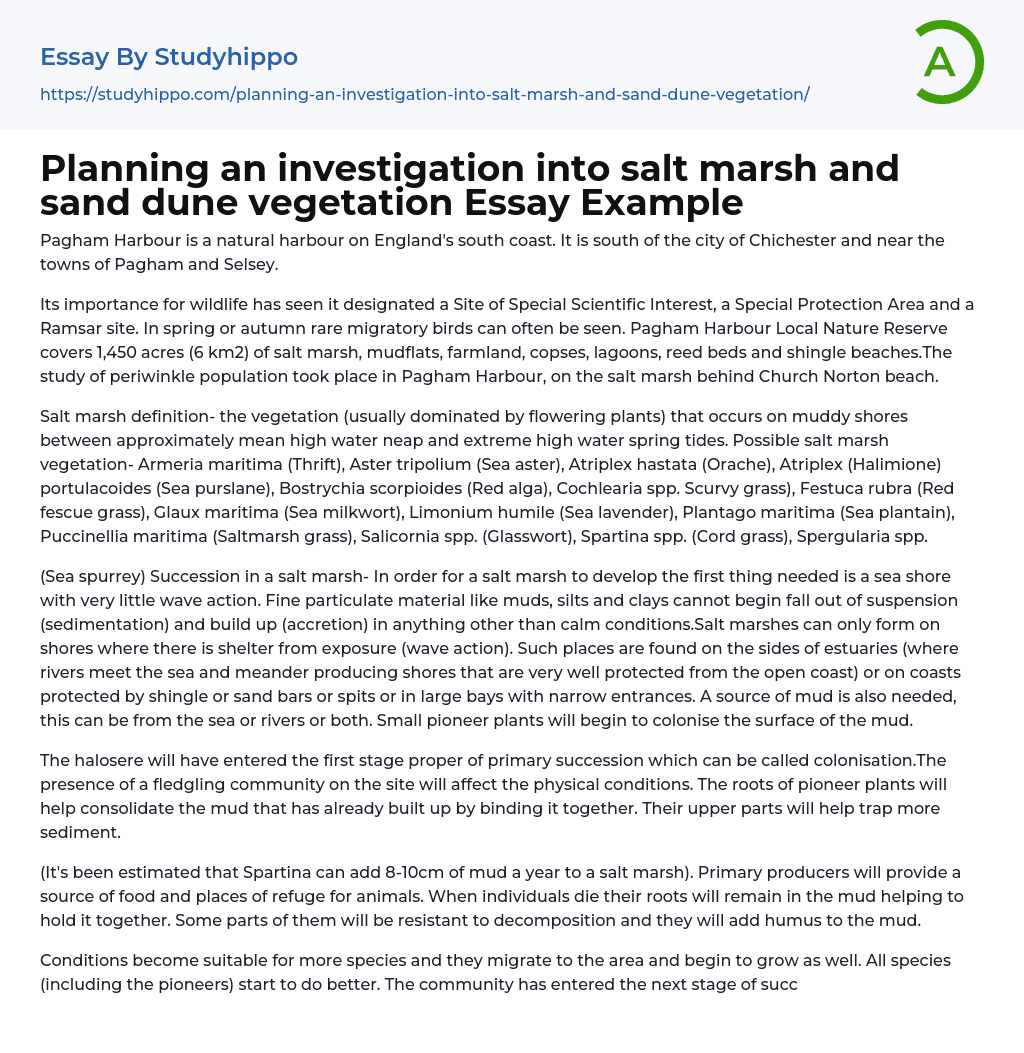

Planning an investigation into salt marsh and sand dune vegetation Essay Example
Pagham Harbour is a natural harbour on England's south coast. It is south of the city of Chichester and near the towns of Pagham and Selsey.
Its importance for wildlife has seen it designated a Site of Special Scientific Interest, a Special Protection Area and a Ramsar site. In spring or autumn rare migratory birds can often be seen. Pagham Harbour Local Nature Reserve covers 1,450 acres (6 km2) of salt marsh, mudflats, farmland, copses, lagoons, reed beds and shingle beaches.The study of periwinkle population took place in Pagham Harbour, on the salt marsh behind Church Norton beach.
Salt marsh definition- the vegetation (usually dominated by flowering plants) that occurs on muddy shores between approximately mean high water neap and extreme high water spring tides. Possible salt marsh vegetation- Armeria maritima (Thrift), Aster tripolium (Sea aster), Atriplex hastata (Orache), Atrip
...lex (Halimione) portulacoides (Sea purslane), Bostrychia scorpioides (Red alga), Cochlearia spp. Scurvy grass), Festuca rubra (Red fescue grass), Glaux maritima (Sea milkwort), Limonium humile (Sea lavender), Plantago maritima (Sea plantain), Puccinellia maritima (Saltmarsh grass), Salicornia spp. (Glasswort), Spartina spp. (Cord grass), Spergularia spp.
(Sea spurrey) Succession in a salt marsh- In order for a salt marsh to develop the first thing needed is a sea shore with very little wave action. Fine particulate material like muds, silts and clays cannot begin fall out of suspension (sedimentation) and build up (accretion) in anything other than calm conditions.Salt marshes can only form on shores where there is shelter from exposure (wave action). Such places are found on the sides of estuaries (where rivers meet the sea and meander producing shores that are very well protected from the open
coast) or on coasts protected by shingle or sand bars or spits or in large bays with narrow entrances. A source of mud is also needed, this can be from the sea or rivers or both. Small pioneer plants will begin to colonise the surface of the mud.
The halosere will have entered the first stage proper of primary succession which can be called colonisation.The presence of a fledgling community on the site will affect the physical conditions. The roots of pioneer plants will help consolidate the mud that has already built up by binding it together. Their upper parts will help trap more sediment.
(It's been estimated that Spartina can add 8-10cm of mud a year to a salt marsh). Primary producers will provide a source of food and places of refuge for animals. When individuals die their roots will remain in the mud helping to hold it together. Some parts of them will be resistant to decomposition and they will add humus to the mud.
Conditions become suitable for more species and they migrate to the area and begin to grow as well. All species (including the pioneers) start to do better. The community has entered the next stage of succession: Establishment. There will be a general increase in number of species at this stage. Seeds of flowering plants from all over the salt marsh will be dispersed by water currents all over the marsh. Some of them will germinate and be found as seedlings at the establishment stage but will not survive to maturity.
As time passes the height of the mud increases.There are more species taking up more space and less bare
ground and the community enters the next stage of development. The species present will compete for space, light, water minerals etc. until those best suited to the environment remain. At this stage there will not be many changes in population type. The height of the ground has increased to such an extent that it gets immersed much less frequently.
The rate of height increase of the shore is reduced. Few if any new species will be added to the community at this stage of stabilisation. This will eventually lead to the climax community.
- Bottled Water essays
- Atmosphere essays
- Biodiversity essays
- Coral Reef essays
- Desert essays
- Earth essays
- Ecosystem essays
- Forest essays
- Lake essays
- Natural Environment essays
- Ocean essays
- Oxygen essays
- Rainbow essays
- Sea essays
- Soil essays
- Volcano essays
- Water essays
- Wind essays
- Business Analysis essays
- Business Plan essays
- Community Development essays
- Competition essays
- Effective Leadership essays
- Leadership Styles essays
- Mission Statement essays
- Negotiation essays
- Outsourcing essays
- Planning essays
- Public relations essays
- Reasoning essays
- Strategic Management essays
- Strategic Planning essays
- Swot Analysis essays



